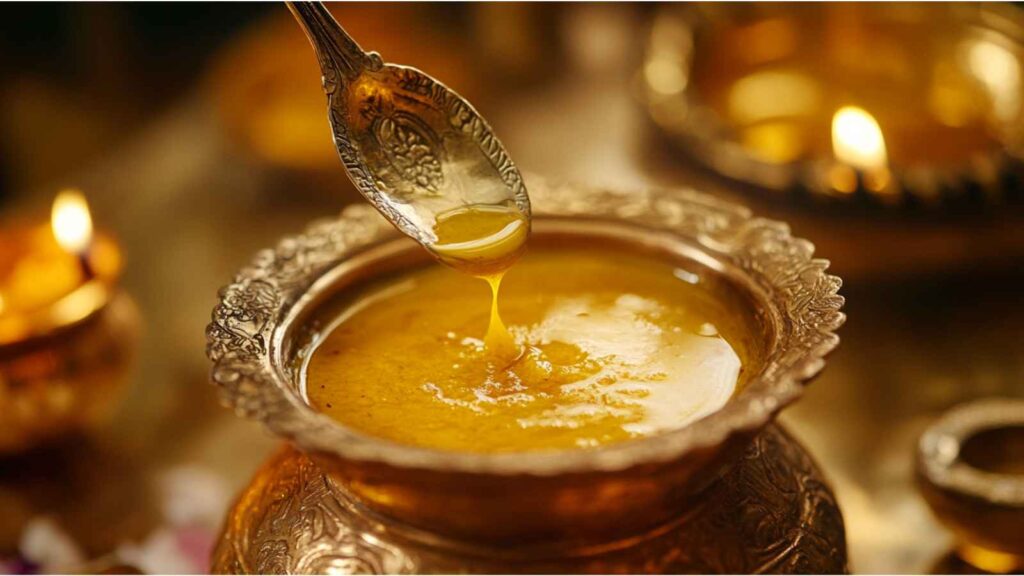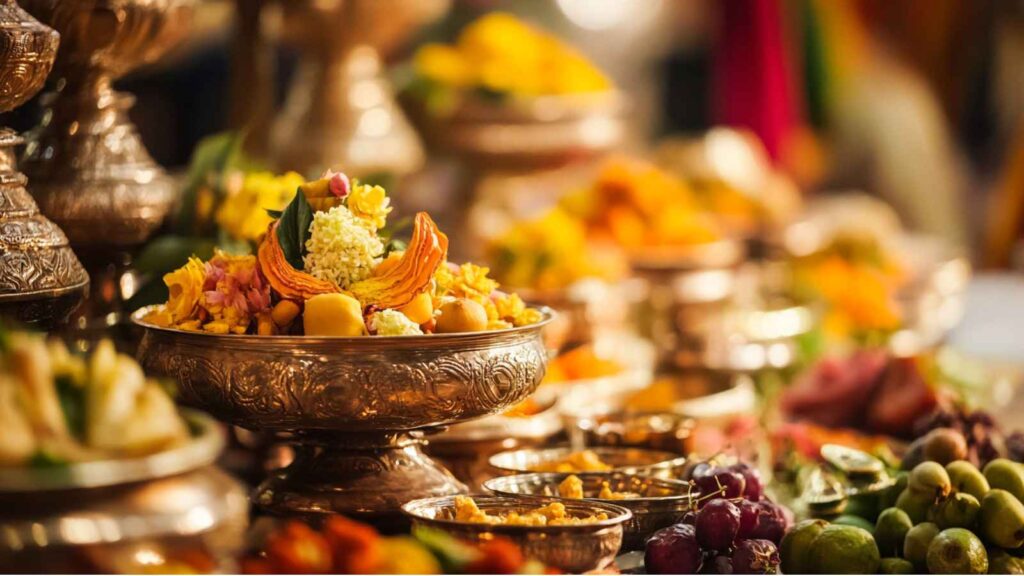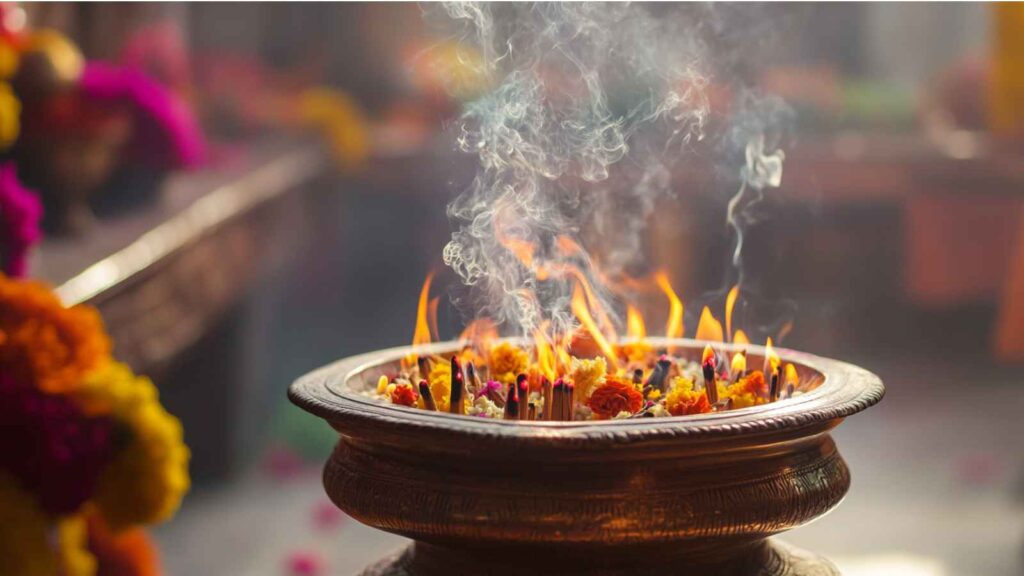Sacred Materials and Objects in Hinduism: Exploring Ghee, Ritual Essentials, and Temple Experiences
Hinduism is a tapestry of diverse traditions, philosophies, and rituals that have evolved over millennia. Central to its spiritual practice are sacred materials and objects that are believed to purify the mind, body, and soul. From the rich, clarifying ghee used in rituals to the delicate fragrance of incense and the symbolic presence of prasad (blessed food), every element holds a deep meaning. These materials not only enhance the spiritual ambiance but also serve as a medium through which the devotee connects with the divine.
Read More About Hindu Philosophy
In this article, we explore a curated list of sacred items including ghee, milk, yogurt, prasad, incense, sandalwood paste, kumkum, sindoor, vibhuti (sacred ash), banana leaves, coconuts, diyas (oil lamps), rudraksha beads, garlands, prayer beads, and altars. We also delve into the foundational scriptures revered for their spiritual, philosophical, and ritual guidance, and examine the role these sacred items play in temple rituals. To offer a complete perspective, we present detailed overviews of select temples—their historical background, architectural highlights, and the enriching visitor experiences they provide.
The Spiritual Significance of Sacred Materials in Hindu Rituals
Ghee: The Divine Elixir

Ghee, or clarified butter, is far more than a culinary ingredient in Hindu culture—it is considered a sacred substance with immense purificatory power. Used extensively in rituals and offerings, ghee is believed to:
- Purify and sanctify: The luminous quality of ghee represents the dispelling of darkness and ignorance.
- Fuel sacred fires: In yajnas (ritualistic fire ceremonies), ghee acts as an ideal fuel that sustains the sacred flames.
- Symbolize purity and nourishment: As a medium in rituals, it signifies the transformation of raw, physical elements into spiritual energy.
Ancient scriptures, including the Vedas, describe ghee as an embodiment of divine essence and a critical component in rituals meant to invoke blessings and spiritual clarity.
Milk and Yogurt: Nourishment for the Soul

Milk and its derivatives such as yogurt are highly valued in Hindu rituals for their purity and nourishing properties. They symbolize:
- Life and fertility: Milk represents sustenance and the nurturing aspects of nature.
- Transformation: Yogurt, as a product of fermentation, is a metaphor for the transformative process of life, turning the ordinary into something sacred.
- Offerings to deities: Both milk and yogurt are common in prasad, offered to deities during poojas and temple rituals.
Prasad (Blessed Food)

Prasad holds a dual role in Hindu practices:
- A symbol of divine grace: It is an edible blessing that devotees receive after rituals.
- A medium for community bonding: Sharing prasad reinforces community ties and the notion of collective spirituality.
- Ritual purity: The preparation of prasad involves meticulous rituals to ensure its sanctity, often incorporating ingredients like ghee, milk, and sugar.
Incense: The Fragrance of Devotion

Incense is used to create a sacred atmosphere during rituals and meditative practices. Its significance includes:
- Purification of the environment: The aromatic smoke cleanses the surroundings of negative energies.
- Invocation of the divine: The rising fragrance is seen as a medium for prayers to reach the heavens.
- Enhancing mindfulness: The consistent aroma helps in focusing the mind during meditation and worship.
Sandalwood Paste: Cooling and Calming
Sandalwood paste is revered for its cooling properties and its ability to calm the mind:
- Spiritual symbolism: It is applied on deities and devotees alike, symbolizing devotion and purity.
- Medicinal qualities: Its natural fragrance is believed to have a soothing effect, aiding in meditation and mindfulness.
- Ritual applications: Often used during abhishekas (ritualistic bathing of deities), sandalwood paste signifies the blending of devotion with sensory pleasure.
Kumkum and Sindoor: Marks of Auspiciousness
These vibrant red powders are deeply embedded in Hindu rituals:
- Symbol of marital bliss and fertility: Sindoor, applied along the hair parting of married women, signifies their marital status and prosperity.
- Representation of divine energy: Kumkum, often used to mark the forehead, represents the third eye and the awakening of inner consciousness.
- Ritual markings: Both are applied during special occasions to denote auspiciousness and spiritual significance.
Vibhuti (Sacred Ash): Reminders of Transience
Vibhuti, or sacred ash, is emblematic of the transient nature of the physical world:
- Memento of renunciation: Its use is a reminder of the ephemeral nature of the material world and the importance of spiritual pursuits.
- Purification ritual: The ash is applied on the forehead as a symbol of cleansing and detachment.
- Spiritual symbolism: Vibhuti represents the impermanence of life and the cycle of creation and destruction.
Banana Leaves and Coconuts: Symbols of Abundance
In Hindu rituals, natural elements like banana leaves and coconuts are employed for their symbolic meanings:
- Offering and prosperity: Banana leaves serve as traditional platters for prasad, symbolizing the earth’s generosity.
- Ritual completeness: Coconuts, often broken during poojas, represent the breaking of ego and the offering of oneself to the divine.
- Purity and auspiciousness: Both items are considered pure and are used to adorn altars and sacred spaces.
Diyas (Oil Lamps): Illuminating the Path
Diyas are one of the most recognized symbols of Hindu spirituality:
- Dispelling darkness: The light of the diya is emblematic of knowledge overcoming ignorance.
- Sacred offerings: They are lit during festivals, poojas, and daily rituals to invoke divine blessings.
- Spiritual symbolism: The steady flame represents the eternal soul and the presence of divinity in everyday life.
Rudraksha Beads: The Cosmic Beads
Rudraksha beads, often used in malas (prayer beads), are considered to have a protective and spiritual influence:
- Symbolic of Lord Shiva: Their origin is steeped in mythology, linking them directly to the divine.
- Aid in meditation: The beads are believed to focus the mind and aid in deep meditation.
- Spiritual protection: Wearing a rudraksha mala is thought to offer physical and spiritual protection.
Garlands and Prayer Beads: Symbols of Devotion
Garlands and prayer beads add an element of beauty and focus to worship:
- Decoration and sanctity: Garlands are often used to adorn deities and temples, enhancing the aesthetic appeal of sacred spaces.
- Spiritual counting: Prayer beads are used for japa (repetitive recitation of mantras), facilitating a meditative and devotional state.
- Symbol of respect: Both garlands and prayer beads are signs of honor and reverence in rituals.
Altars: The Sacred Spaces
The altar is the physical focal point of any Hindu temple or home shrine:
- Center of worship: It serves as the designated space where rituals, prayers, and offerings are performed.
- Symbolic representation: The altar embodies the meeting point of the divine and the mortal, a space where devotees seek blessings and spiritual guidance.
- Ritual importance: Properly arranged altars, complete with sacred materials, are essential for maintaining the sanctity of the worship area.
Foundational Scriptures and Their Guidance
Hindu rituals and the use of sacred materials are deeply rooted in ancient scriptures that guide the spiritual life of its followers. Some of the most revered texts include:
The Vedas
- Rigveda, Yajurveda, Samaveda, and Atharvaveda: These ancient texts provide the earliest insights into the ritualistic use of sacred materials like ghee, milk, and incense. They outline the procedures for yajnas and other ceremonies that have been followed for centuries.
- Spiritual insights: The Vedas stress the importance of purity, both physical and spiritual, which is symbolized through the use of these sacred substances.
Upanishads
- Philosophical depth: The Upanishads explore the nature of the self, the universe, and the divine. They encourage the transformation of everyday elements into symbols of spiritual awakening.
- Guidance on rituals: Texts like the Katha Upanishad and Chandogya Upanishad provide subtle insights into the metaphysical significance of items like vibhuti and rudraksha beads.
Bhagavad Gita
- Ethical and moral guidance: Part of the Mahabharata, the Bhagavad Gita offers a dialogue on duty, righteousness, and devotion. It highlights the importance of selfless action and the purification of the mind through ritual practices.
- Spiritual symbolism: Many references to sacred objects in the Gita underline their role in helping the devotee connect with the eternal divine.
Puranas
- Mythological narratives: The Puranas, including the Shiva, Vishnu, and Devi Puranas, narrate the stories behind many ritual items. For instance, the lore surrounding rudraksha beads and the significance of ghee in religious ceremonies are elaborated upon in these texts.
- Cultural context: The Puranas ensure that the rituals remain alive in the cultural memory of the people, bridging the gap between myth and daily practice.
Sacred Materials and Temple Rituals: A Closer Look at Hindu Temples
Temples in Hinduism are more than just places of worship—they are living embodiments of the divine and serve as centers for spiritual education and cultural preservation. Here, we detail a framework to explore the sacred materials within temple settings, using examples of prominent temples to illustrate how historical background, architectural brilliance, and visitor experiences come together.
1. Kedarnath Temple, Uttarakhand
Historical Background
Kedarnath Temple, nestled in the high reaches of the Himalayas in Uttarakhand, is one of the twelve Jyotirlingas dedicated to Lord Shiva. Its history dates back to ancient times and is steeped in legend. According to Hindu mythology, the temple was established by the Pandavas during their period of exile, and later rejuvenated by Adi Shankaracharya in the 8th century CE. This temple symbolizes the eternal presence of Shiva and remains a major pilgrimage site despite its remote location.
Architectural Highlights
- Rock-cut architecture: The Kedarnath Temple is renowned for its simple yet robust rock architecture, which harmonizes with the harsh Himalayan landscape.
- Spiritual symbolism: The temple’s design reflects ancient Vedic principles, incorporating natural elements like stone and wood to create a sacred ambience.
- Sacred materials in rituals: During rituals, offerings of ghee, milk, and vibhuti are used to invoke divine blessings, harmonizing with the temple’s austere yet spiritual design.
Visitor Experience
- Pilgrimage journey: Devotees undertake a challenging trek to Kedarnath, finding that the physical journey mirrors the spiritual journey.
- Tranquil ambiance: The serene environment, combined with ritualistic chanting and the natural sounds of the mountains, creates an immersive spiritual experience.
- Ritual participation: Visitors can witness traditional rituals, where sacred items such as incense, diyas, and rudraksha beads are integral, deepening their understanding of Hindu spirituality.
2. Tirumala Tirupati Balaji Temple, Andhra Pradesh
Historical Background
Situated in the town of Tirumala in Andhra Pradesh, Tirupati Balaji Temple is one of the most visited and venerated temples dedicated to Lord Venkateswara, an incarnation of Vishnu. Its origins trace back several centuries, and the temple has grown into a monumental institution of faith, patronized by millions of devotees each year.
Architectural Highlights
- Dravidian style: The temple showcases exquisite Dravidian architecture with towering gopurams (gateway towers) that are decorated with intricate sculptures and carvings.
- Integration of sacred objects: Ritual items such as ghee and incense play a vital role in daily worship, with the temple’s architecture designed to accommodate the flow of divine energy through carefully arranged altars and sanctuaries.
- Innovative design elements: Modern restoration efforts have enhanced the temple’s infrastructure while maintaining its ancient charm and sacred atmosphere.
Visitor Experience
- Devotional fervor: Visitors experience an overwhelming sense of devotion as they participate in the elaborate poojas and rituals, where prasad, diyas, and garlands are offered with utmost reverence.
- Cultural immersion: The temple complex also serves as a hub for cultural programs, religious discourses, and community service, enabling devotees to experience a holistic approach to spirituality.
- Spiritual rejuvenation: The meticulous use of sacred materials—from ghee and milk in rituals to sandalwood paste and vibhuti on the deities—adds to the immersive spiritual environment, leaving a lasting impact on visitors.
3. Jagannath Temple, Puri, Odisha
Historical Background
Jagannath Temple in Puri is another iconic Hindu pilgrimage destination, primarily dedicated to Lord Jagannath, along with his siblings Balabhadra and Subhadra. With a history spanning over a thousand years, this temple is central to the annual Rath Yatra (Chariot Festival) and is celebrated for its deep-rooted cultural significance and mythological narratives.
Architectural Highlights
- Ornate design: The temple’s architecture is distinguished by its towering spires, intricate carvings, and expansive courtyards that host various ritualistic activities.
- Cultural symbolism: The temple integrates numerous sacred objects in its rituals, where offerings like ghee, milk, and prasad are part of the daily worship, symbolizing purity and divine nourishment.
- Sacred layout: The temple’s design reflects ancient cosmic principles, ensuring that the flow of spiritual energy through altars and prayer spaces is unhindered.
Visitor Experience
- Festive vibrancy: The annual Rath Yatra transforms the temple into a hub of festivities, where visitors witness elaborate decorations, vibrant garlands, and the communal distribution of prasad.
- Spiritual immersion: Tourists and devotees alike are enveloped by the temple’s spiritual aura, enhanced by the fragrance of incense and the soft glow of diyas, which together create an unforgettable experience.
- Community connection: The temple acts as a cultural melting pot, where historical rituals meet contemporary practices, offering visitors a glimpse into the living traditions of Hindu worship.
The Role of Sacred Materials in Enriching Spiritual Practices
Sacred materials are not mere ritualistic paraphernalia—they are the very essence of Hindu devotional practices. Their multifaceted roles include:
- Enhancing Ritual Purity: Items like ghee, milk, and sandalwood paste are used to purify both the physical environment and the devotee’s mind. They help create a sacred space where the divine can be invoked.
- Symbolic Representations: Each item is rich with symbolic meaning. For instance, vibhuti reminds devotees of the transient nature of the world, while rudraksha beads symbolize protection and inner strength.
- Facilitating Devotional Practices: Whether through lighting a diya or offering a garland, these objects aid in maintaining focus during meditation and prayer, deepening the devotee’s connection with the divine.
- Bridging the Material and the Spiritual: The transformation of everyday substances into sacred materials is a recurring theme in Hinduism, reflecting the belief that every aspect of life holds the potential for spiritual awakening.
Foundational Scriptures: The Guiding Light
The sacred texts of Hinduism provide comprehensive instructions on the use and symbolism of these sacred materials. Their teachings are not only ritualistic guidelines but also philosophical treatises that address the nature of reality and the purpose of life.
- The Vedas prescribe detailed procedures for rituals, emphasizing purity and the transformative power of substances like ghee and milk.
- The Upanishads elevate these practices by linking them to the quest for self-realization, urging practitioners to see beyond the material to the underlying spiritual truth.
- The Bhagavad Gita offers insights into the moral and ethical dimensions of ritualistic practice, urging believers to engage in actions with devotion and detachment.
- The Puranas weave myth and ritual into the cultural fabric, ensuring that the symbolic use of these objects remains accessible to devotees across generations.
These texts collectively ensure that the sacred materials are not only seen as physical offerings but also as symbols of the spiritual journey—a journey that transcends time and space.


